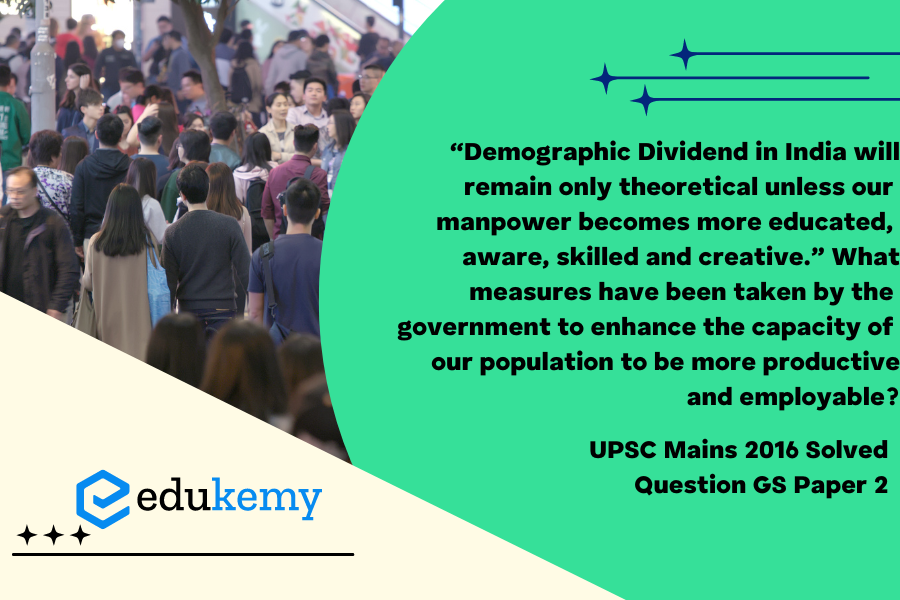The demographic dividend in India, characterized by a large working-age population, holds immense potential for economic growth and development. However, this advantage can only be harnessed if our manpower is equipped with education, awareness, skills, and creativity. Mere demographic abundance is insufficient; a proactive approach is essential to ensure that the population becomes not only more numerous but also more productive and employable. Recognizing this imperative, the Indian government has implemented several measures to enhance the capacity of its people.
To begin with, the government has prioritized education, introducing initiatives like the Sarva Shiksha Abhiyan and the Right to Education Act, aiming to provide quality education to all. Skill development programs, such as Skill India and the National Skill Development Mission, have been launched to bridge the gap between education and employability. Moreover, awareness campaigns on various fronts, including health and hygiene, have been promoted to create a more informed populace. The emphasis on digital literacy and technological training further aligns the workforce with the demands of a rapidly evolving global economy.
Tag: Development processes and the development industry —the role of NGOs, SHGs, various groups and associations, donors, charities, institutional and other stakeholders.
Contents
Decoding the Question:
- In the Introduction, try to define a Demographic Dividend.
- In Body, discuss the measures taken by the government to enhance the capacity of our population to be more productive and employable.
- In Conclusion, try to mention the importance of demographic dividend for India.
Answer:
If India has to reap the benefits of the ‘demographic dividend’ in the years ahead, investments in social infrastructure by way of education, skill development, training, and provision of healthcare facilities must be made to enhance the productivity of the workforce and the welfare of the population.
United Nations Population Fund (UNFPA) defines a demographic dividend as the economic growth potential that can result from shifts in a population’s age structure, mainly when the share of the working-age population (15-64) is larger than the non-working age share of the population (14 and younger, 65 and older). At present, India has around 62.5% of its population in the age group of 15-59 years which is ever-increasing and will be at the peak around 2036 and reach approximately 65%.



Measures taken by the Government to Enhance the Capacity of Population:
- Setting up of National Skill Development Corporation (NSDC) under Pradhan Mantri Kaushal Vikas Yojana to offer meaningful, industry-relevant, skill-based training to the Indian youth as well as a government certification on successful completion of training to help them secure a job in the future.
- Along with the Right to Education Act, several Scholarship schemes are in operation to encourage enrolment and learning levels among different groups.
- Initiated the National Literacy Mission to raise the literacy rate to 80 percent and reduce the gender gap to less than 10 percent.
- The National Policy on Education, 1986 emphasizes the removal of disparity among different social classes by ensuring equality of educational opportunities.
- To take full advantage of the demographic dividend, India not only needs an educated but also a healthy population. For this, India has started the National Health Mission (NHM) encompassing its two sub-missions. National Rural Health Mission and National Urban Health Mission, to achieve universal access to equitable, affordable, and quality healthcare services.
India has the potential to achieve a much faster pace of economic growth than both China and the US. Its demographic profile can be further improved by investing in physical and human infrastructure, increasing female labor force participation, technological innovation, boosting savings, etc. Though India has initiated all pertinent programs and policies, to make the dream of a demographic dividend a reality the key lies in their effective and efficient implementation.
In case you still have your doubts, contact us on 9811333901.
For UPSC Prelims Resources, Click here
For Daily Updates and Study Material:
Join our Telegram Channel – Edukemy for IAS
- 1. Learn through Videos – here
- 2. Be Exam Ready by Practicing Daily MCQs – here
- 3. Daily Newsletter – Get all your Current Affairs Covered – here
- 4. Mains Answer Writing Practice – here


